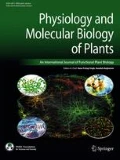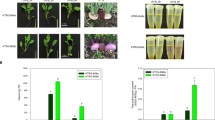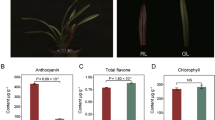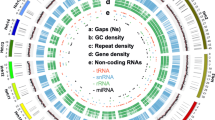Abstract
Rhododendron delavayi is an alpine evergreen ornamental plant, but water shortage limits its growth and development in urban gardens. However, the adaptive mechanism of alpine evergreen rhododendrons to drought remains unclear. Here, a water control experiment was conducted to study the physiological and transcriptomic response of R. delavayi to drought. The drought treatment for 9 days decreased photosynthetic rate, induced accumulation of reactive oxygen species (ROS), and damaged chloroplast ultrastructure of R. delavayi. However, the photosynthetic rate quickly recovered to the level before treatment when the plants were re-watered. De novo assembly of RNA-Seq data generated 86,855 unigenes with an average length of 1870 bp. A total of 22,728 differentially expressed genes (DEGs) were identified between the control and drought plants. The expression of most DEGs related to photosynthesis were down-regulated during drought stress, and were up-regulated when the plants were re-watered, including the DEGs encoding subunits of light-harvesting chlorophyll-protein complex, photosystem II and photosystem I reaction center pigment-protein complexes, and photosynthetic electron transport. The expressions of many DEGs related to signal transduction, flavonoid biosynthesis and antioxidant activity were also significantly affected by drought stress. The results indicated that the response of R. delavayi to drought involved multiple physiological processes and metabolic pathways. Photosynthetic adjustment, ROS-scavenging system, abscisic acid and brassinosteroid signal transduction pathway may play important roles to improve drought tolerance of R. delavayi. Our findings provided valuable information for understanding the mechanisms of drought tolerance employed by Rhododendron species.










Similar content being viewed by others
Abbreviations
- ABA:
-
Abscisic acid
- ABF:
-
ABRE-binding factor
- ANS:
-
Anthocyanidin synthase
- APX:
-
Ascorbate peroxidase
- CAT:
-
Catalase
- CHS:
-
Chalcone synthase
- COG:
-
Clusters of orthologous groups of protein
- DEGs:
-
Differentially expressed genes
- DFR:
-
Dihydroflavonol-4-reductase
- F3H:
-
Flavanone 3-hydroxylase
- FDR:
-
False discovery rate
- FLS:
-
Flavonol synthase
- GO:
-
Gene ontology
- Gs:
-
Stomatal conductance
- GSH:
-
Glutathione peroxidase
- KEGG:
-
Kyoto encyclopedia of genes and genomes
- LHC:
-
Light-harvesting chlorophyll–protein complex
- MDA:
-
Malondialdehyde
- Nr:
-
Non-redundant protein
- OG:
-
Osmiophilic granules
- Pn :
-
Net photosynthetic rate
- POD:
-
Peroxidase
- PRX:
-
Peroxiredoxins
- PS I:
-
Photosystem I
- PS II:
-
Photosystem II
- ROS:
-
Reactive oxygen species
- SOD:
-
Superoxide dismutase
- STEM:
-
Short time-series expression miner
- TEM:
-
Transmission electron microscopy
- Tr :
-
Transpiration rate
References
Adie BA, Perez-Perez J, Perez-Perez MM, Godoy M, Sanchez-Serrano JE, Solano R (2007) ABA is an essential signal for plant resistance to pathogens affecting JA biosynthesis and the activation of defenses in Arabidopsis. Plant Cell 19:1665–1681. https://doi.org/10.1105/tpc.106.048041
Cai YF, Li SF, Li SF, Xie WJ, Song J (2014) How do leaf anatomies and photosynthesis of three Rhododendron species relate to their natural environments? Bot Stud 55:36–45. https://doi.org/10.1186/1999-3110-55-36
Cai YF, Wang JH, Li SF, Zhang L, Peng LC, Xie WJ, Liu FH (2015) Photosynthetic response of an alpine plant, Rhododendron delavayi Franch, to water stress and recovery: the role of mesophyll conductance. Front Plant Sci 6:1089. https://doi.org/10.3389/fpls.2015.01089
Campos H, Trejo C, Peña-Valdivia CB, García-Nava R, Conde-Martínez FV, Cruz-Ortega MR (2014) Stomatal and non-stomatal limitations of bell pepper (Capsicum annuum L.) plants under water stress and re-watering: delayed restoration of photosynthesis during recovery. Environ Exp Bot 98:56–64. https://doi.org/10.1016/j.envexpbot.2013.10.015
Carvalho MHC (2008) Drought stress and reactive oxygen species: production, scavenging and signaling. Plant Signal Behav 3:156–165. https://doi.org/10.4161/psb.3.3.5536
Chaves MM, Flexas J, Pinheiro C (2009) Photosynthesis under drought and salt stress: regulation mechanisms from whole plant to cell. Ann Bot 103:551–560. https://doi.org/10.1093/aob/mcn125
Chen D, Liang MX, DeWald D, Weimer B, Peel MD, Bugbee B (2008) Identification of dehydration responsive genes from two non-nodulated alfalfa cultivars using Medicago truncatula microarrays. Acta Physiol Plant 30:183–199. https://doi.org/10.1007/s11738-007-0107-5
Choi YS, Kim YM, Hwang OJ, Han YJ (2013) Overexpression of Arabidopsis ABF3 gene confers enhanced tolerance to drought and heat stress in creeping bentgrass. Plant Biotechnol Rep 7:165–173. https://doi.org/10.1007/s11816-012-0245-0
Ernst J, Bar-Joseph Z (2006) STEM: a tool for the analysis of short time series gene expression data. BMC Bioinform 7:191. https://doi.org/10.1186/1471-2105-7-191
Fang MY, Fang RZ, He MY, Hu LZH, Yang HP (2005) Flora of China, vol 14. Science Press, Beijing, pp 260–455
Fernàndez-Martínez J, Fransi MA, Fleck I (2016) Ecophysiological responses of Betula pendula, Pinus uncinata and Rhododendron ferrugineum in the Catalan Pyrenees to low summer rainfall. Tree Physiol 36:1520–1535. https://doi.org/10.1093/treephys/tpw104
Flexas J, Bota J, Galmés J, Medrano H, Ribas-Carbó M (2006) Keeping a positive carbon balance under adverse conditions: responses of photosynthesis and respiration to water stress. Physiol Plant 127:343–352. https://doi.org/10.1111/j.1399-3054.2006.00621.x
Flexas J, Barón M, Bota J, Ducruet JM, Gallé A, Galmés J, Jiménez M, Pou A, Ribas-Carbó M, Sajnani C, Tomàs M, Medrano H (2009) Photosynthesis limitations during water stress acclimation and recovery in the drought-adapted Vitis hybrid Richter-110 (V. berlandierix V. rupestris). J Exp Bot 60:2361–2377. https://doi.org/10.1093/jxb/erp069
Fujita Y, Yoshida T, Yamaguchi Shinozaki K (2013) Pivotal role of the AREB/ABF-SnRK2 pathway in ABRE-mediated transcription in response to osmotic stress in plants. Physiol Plant 147:15–27. https://doi.org/10.1111/j.1399-3054.2012.01635.x
Götz S, García-Gómez JM, Terol J, Williams TD, Nagaraj SH, Nueda MJ, Robles M, Talón M, Dopazo J, Conesa A (2008) High-throughput functional annotation and data mining with the Blast2GO suite. Nucleic Acids Res 36:3420–3435. https://doi.org/10.1093/nar/gkn176
Gruszka D, Szarejko I, Maluszynski M (2011) Identification of barley DWARF gene involved in brassinosteroid synthesis. Plant Growth Regul 65:343–358. https://doi.org/10.1007/s10725-011-9607-9
Gruszka D, Janeczko A, Dziurka M, Pociecha E, Oklestkova J, Szarejko I (2016) Barley brassinosteroid mutants provide an insight into phytohormonal homeostasis in plant reaction to drought stress. Front Plant Sci 7:1824. https://doi.org/10.3389/fpls.2016.01824
He LS, Su JL, Liu XQ, Li C, Chen SP, Xiang LP (2001) The effects of drought stress on photosynthetic physiological characteristics of Rhododendron hybrides ‘Cosmopolitan’ simulated by PEG. J Suzhou Univ Sci Technol (Nat Sci) 28(4):62–66 (in Chinese)
Horton P, Ruban AV, Rees D, Pascal AA, Noctor G, Young AJ (1991) Control of the light-harvesting function of chloroplast membranes by aggregation of the LHCII chlorophyll–protein complex. FEBS Lett 292:1–4. https://doi.org/10.1016/0014-5793(91)80819-O
Huang CL, Chen X, Gao GL (2011) Physiological response of seedlings of three azalea species of drought stress and evaluation of drought resistance. Sci Silvae Sin 47:48–55 (in Chinese)
Irwin RB, Anciso A, Jones PJ, Glenn AL, Williams BL, Sridhar S, Arshad S (2009) Transmission electron microscopy specimen preparation perpendicular to the long axis of high aspect ratio features. J Vac Sci Technol 27:1352–1359. https://doi.org/10.1116/1.3248271
Joshi R, Wani SH, Singh B, Bohra A, Dar ZA, Lone AA, Pareek A, Singla-Pareek SL (2016) Transcription factors and plants response to drought stress: current understanding and future directions. Front Plant Sci 7:1029. https://doi.org/10.3389/fpls.2016.01029
Kang Y, Han Y, Torres-Jerez I, Wang M, Tang Y, Monteros M (2011) System responses to long-term drought and re-watering of two contrasting alfalfa varieties. Plant J 68:871–889. https://doi.org/10.1111/j.1365-313X.2011.04738.x
Khan F, Upreti P, Singh R, Shukla PK, Shirke PA (2017) Physiological performance of two contrasting rice varieties under water stress. Physiol Mol Biol Plants 23:85–97. https://doi.org/10.1007/s12298-016-0399-2
Lemke P, Ren R, Alley I (2007) The physical science basis. Contribution of working group I to the fourth assessment report of the intergovernmental panel on climate change. Cambridge University Press, Cambridge, pp 337–383
Li J, Wen J, Lease KA, Doke JT, Tax FE, Walker JC (2002) BAK1, an Arabidopsis LRR receptor-like protein kinase, interacts with BRI1 and modulates brassinosteroid signaling. Cell 110:213–222. https://doi.org/10.1016/S0092-8674(02)00812-7
Li R, Yu C, Li Y, Lam TW, Yiu SM, Kristiansen K, Wang J (2009) SOAP2: an improved ultrafast tool for short read alignment. Bioinformatics 25:1966–1967. https://doi.org/10.1093/bioinformatics/btp336
Li H, Yao W, Fu Y, Li S, Guo Q (2015) De novo assembly and discovery of genes that are involved in drought tolerance in Tibetan Sophora moorcroftiana. PLoS ONE 10:e111054. https://doi.org/10.1371/journal.pone.0111054
Li XJ, Guo X, Zhou YH, Shi K, Zhou J, Yu JQ (2016) Overexpression of a brassinosteroid biosynthetic gene dwarf enhances photosynthetic capacity through activation of Calvin cycle enzymes in tomato. BMC Plant Biol 16:33. https://doi.org/10.1186/s12870-016-0715-6
Li YH, Zhang HN, Wu QS, Muday GK (2017) Transcriptional sequencing and analysis of major genes involved in the adventitious root formation of mango cotyledon segments. Planta 245:1193–1213. https://doi.org/10.1007/s00425-017-2677-9
Liu M, Li X, Liu Y, Cao B (2013) Regulation of flavanone 3-hydroxylase gene involved in the flavonoid biosynthesis pathway in response to UV-B radiation and drought stress in the desert plant, Reaumuria soongorica. Plant Physiol Biochem 73:161–167. https://doi.org/10.1016/j.plaphy.2013.09.016
Livak KJ, Schmittgen TD (2001) Analysis of relative gene expression data using real-time quantitative PCR and the 2−ΔΔCT method. Methods 25:402–408. https://doi.org/10.1006/meth.2001.1262
Ma D, Sun D, Wang C, Li Y, Guo T (2014) Expression of flavonoid biosynthesis genes and accumulation of flavonoid in wheat leaves in response to drought stress. Plant Physiol Biochem 80:60–66. https://doi.org/10.1016/j.plaphy.2014.03.024
Ma X, Xia H, Liu Y, Wei H, Zheng X, Song C, Chen L, Liu H, Luo L (2016) Transcriptomic and metabolomic studies disclose key metabolism pathways contributing to well-maintained photosynthesis under the drought and the consequent drought-tolerance in rice. Front Plant Sci 7:1886. https://doi.org/10.3389/fpls.2016.01886
Mehrotra R, Bhalothia P, Bansal P, Basantani MK, Bharti V, Mehrotra S (2014) Abscisic acid and abiotic stress tolerance-different tiers of regulation. J Plant Physiol 171:486–496. https://doi.org/10.1016/j.jplph.2013.12.007
Mortazavi A, Williams BA, McCue K, Schaeffer L, Wold B (2008) Mapping and quantifying mammalian transcriptomes by RNA-Seq. Nat Methods 5:621–628. https://doi.org/10.1038/nmeth.1226
Nakabayashi R, Yonekura-Sakakibara K, Urano K, Suzuki M, Yamada Y, Nishizawa T, Matsuda F, Kojima M, Sakakibara H, Shinozaki K, Michael AJ, Tohge T, Yamazaki M, Saito K (2014) Enhancement of oxidative and drought tolerance in Arabidopsis by overaccumulation of antioxidant flavonoids. Plant J 77:367–379. https://doi.org/10.1111/tpj.12388
Pizzio GA, Rodriguez L, Antoni R, Gonzalez-Guzman M, Yunta C (2013) The PYL4 A194T mutant uncovers a key role of PYR1-LIKE4/PROTEIN PHOSPHATASE 2CA interaction for abscisic acid signaling and plant drought resistance. Plant Physiol 163:441–455. https://doi.org/10.1104/pp.113.224162
Raghavendra AS, Gonugunta VK, Christmann A, Grill E (2010) ABA perception and signalling. Trends Plant Sci 15:395–401. https://doi.org/10.1016/j.tplants.2010.04.006
Ranjan A, Pandey N, Lakhwani D, Dubey NK, Pathre UV, Sawant SV (2012) Comparative transcriptomic analysis of roots of contrasting Gossypium herbaceum genotypes revealing adaptation to drought. BMC Genom 13:680. https://doi.org/10.1186/1471-2164-13-680
Rasmussen S, Barah P, Suarez-Rodriguez MC, Bressendorff S, Friis P, Costantino P (2013) Transcriptome responses to combinations of stresses in Arabidopsis. Plant Physiol 161:1783–1794. https://doi.org/10.1104/pp.112.210773
Saibo NJ, Lourenco T, Oliveira MM (2009) Transcription factors and regulation of photosynthetic and related metabolism under environmental stresses. Ann Bot 103:609–623. https://doi.org/10.1093/aob/mcn227
Shakirova F, Allagulova C, Maslennikova D, Fedorova K, Yuldashev R, Lubyanova A (2016) Involvement of dehydrins in 24-epibrassinolide-induced protection of wheat plants against drought stress. Plant Physiol Biochem 108:539–548. https://doi.org/10.1016/j.plaphy.2016.07.013
Soares C, Sousa AD, Pinto A, Azenha M, Teixeira J, Azevedo RA (2016) Effect of 24-epibrassinolide on ROS content, antioxidant system, lipid peroxidation and Ni uptake in Solanum nigrum L. under Ni stress. Environ Exp Bot 122:115–125. https://doi.org/10.1016/j.envexpbot.2015.09.010
Talbi S, Romero-Puertas MC, Hernández A, Terrón L, Ferchichi A, Sandalio LM (2015) Drought tolerance in a Saharian plant Oudneya africana: role of antioxidant defences. Environ Exp Bot 111:114–126. https://doi.org/10.1016/j.envexpbot.2014.11.004
Xu Y, Gao S, Yang Y, Huang M, Cheng L, Qian W (2013) Transcriptome sequencing and whole genome expression profiling of chrysanthemum under dehydration stress. BMC Genom 14:662–677. https://doi.org/10.1186/1471-2164-14-662
Yamada M, Morishita H, Urano K, Shiozaki N, Yamaguchi-Shinozaki K, Shinozaki K (2005) Effects of free proline accumulation in petunias under drought stress. J Exp Bot 56:1975–1981. https://doi.org/10.1093/jxb/eri195
Yoshida R, Umezawa T, Mizoguchi T, Takahashi S, Takahashi F, Shinozaki K (2006) The regulatory domain of SRK2E/OST1/SnRK2.6 interacts with ABI1 and integrates abscisic acid (ABA) and osmotic stress signals controlling stomatal closure in Arabidopsis. J Biol Chem 281:5310–5318. https://doi.org/10.1074/jbc.M509820200
Yuan GF, Jia CG, Li Z, Sun B, Zhang LP, Liu N (2010) Effect of brassinosteroids on drought resistance and abscisic acid concentration in tomato under water stress. Sci Hortic 126:103–108. https://doi.org/10.1016/j.scienta.2010.06.014
Yuan Y, Qi L, Yang J, Wu C, Liu Y, Huang L (2015) A Scutellaria baicalensis R2R3-MYB gene, SbMYB8, regulates flavonoid biosynthesis and improves drought stress tolerance in transgenic tobacco. Plant Cell Tissue Org Cult 120:961–972. https://doi.org/10.1007/s11240-014-0650-x
Zhang CQ, Luo JF, Su YF (2002) The research of drought tolerance on 6 species of Rhododendron. Guihaia 22:174–176 (in Chinese)
Zhang MC, Zhai ZX, Tian XL, Duan L, Li Z (2008) Brassinolide alleviated the adverse effect of water deficits on photosynthesis and the antioxidant of soybean (Glycine max L.). Plant Growth Regul 56:257–264. https://doi.org/10.1007/s10725-008-9305-4
Zhang M, Pan DR, Zhou YF (2012) Analysis of the flavonoids in the leaves of Rhododendron pulchrum Sweet by HPLC-MS. J Anhui Agri Sci 3(6):21–24
Zhang ZF, Li YY, Xiao BZ (2016) Comparative transcriptome analysis highlights the crucial roles of photosynthetic system in drought stress adaptation in upland rice. Sci Rep 6:19349. https://doi.org/10.1038/srep19349
Acknowledgements
Funding was provided by National Natural Science Foundation of China (Grant Nos. 31760229, 31670342), Program of Science and Technology Talents Training in Yunnan Province (Grant No. 2016HA005), Science and Technology Plan of Yunnan Province (Grant No. 2015BB013), and Applied Basic Research Project of Yunnan Province (Grant No. 2016FB058).
Author information
Authors and Affiliations
Corresponding author
Additional information
Publisher's Note
Springer Nature remains neutral with regard to jurisdictional claims in published maps and institutional affiliations.
Electronic supplementary material
Below is the link to the electronic supplementary material.
Rights and permissions
About this article
Cite this article
Cai, YF., Wang, JH., Zhang, L. et al. Physiological and transcriptomic analysis highlight key metabolic pathways in relation to drought tolerance in Rhododendron delavayi. Physiol Mol Biol Plants 25, 991–1008 (2019). https://doi.org/10.1007/s12298-019-00685-1
Received:
Revised:
Accepted:
Published:
Issue Date:
DOI: https://doi.org/10.1007/s12298-019-00685-1




